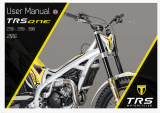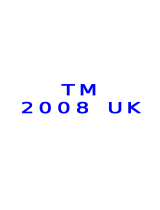
Index
CHAPTER 1: GENERAL INFORMATION
INDEX OF TOPICS
Main parts
..........................................................................................................................................................................................................................46
Vehicle identification details .................................................................................................................................................................................46
Engine identification details ..................................................................................................................................................................................46
Console and controls ..................................................................................................................................................................................................46
Technical details .............................................................................................................................................................................................................47
Wiring scheme ................................................................................................................................................................................................................48
CHAPTER 2: Operation and Use
INDEX OF TOPICS
Filling the fuel tank
......................................................................................................................................................................................................50
Start-up ...............................................................................................................................................................................................................................50
Advance map change switch ................................................................................................................................................................................ 51
Break-in .............................................................................................................................................................................................................................52
Checks and maintenance before and after off-road use ..................................................................................................................52
Recommended lubricants and liquids .............................................................................................................................................................53
CHAPTER 3: MAINTENANCE AND CHECKS
INDEX OF TOPICS
Lubrication circuit
.........................................................................................................................................................................................................55
Engine oil ............................................................................................................................................................................................................................56
Brake master cylinder fluid ...................................................................................................................................................................................59
Brakes circuit bleeding ............................................................................................................................................................................................60
Clutch master cylinder fluid ..................................................................................................................................................................................62
Clutch circuit bleeding ...............................................................................................................................................................................................62
Fork oil ................................................................................................................................................................................................................................63
Sparkplug ..........................................................................................................................................................................................................................64
Air filter ..............................................................................................................................................................................................................................65
Ignition generator check .........................................................................................................................................................................................66
Front brake ......................................................................................................................................................................................................................67
Rear brake ........................................................................................................................................................................................................................68
Coolant ................................................................................................................................................................................................................................69
Rear suspension linkage .........................................................................................................................................................................................70
Checks after cleaning ................................................................................................................................................................................................70
Scheduled maintenance ........................................................................................................................................71
CHAPTER 4: ADJUSTMENTS
INDEX OF TOPICS
Brake adjustment
........................................................................................................................................................................................................73
Clutch adjustment .......................................................................................................................................................................................................73
Carburettor ......................................................................................................................................................................................................................74
Tickover adjustment ..................................................................................................................................................................................................74
Throttle free clearance adjustment .................................................................................................................................................................74
Checking and adjusting steering clearance ................................................................................................................................................74
Chain tension ..................................................................................................................................................................................................................75
Front suspension adjustment ..............................................................................................................................................................................76
Rear shockabsorber adjustment .......................................................................................................................................................................76
CHAPTER 5: WHAT TO DO IN AN EMERGENCY
INDEX OF TOPICS
Troubleshooting
.............................................................................................................................................................................................................78
Pag.




















 1
1
 2
2
 3
3
 4
4
 5
5
 6
6
 7
7
 8
8
 9
9
 10
10
 11
11
 12
12
 13
13
 14
14
 15
15
 16
16
 17
17
 18
18
 19
19
 20
20
 21
21
 22
22
 23
23
 24
24
 25
25
 26
26
 27
27
 28
28
 29
29
 30
30
 31
31
 32
32
 33
33
 34
34
 35
35
 36
36
 37
37
 38
38
Classic Accessories 32-013-010501-00 Owner's manual
 TRS One 300 2016 User manual
TRS One 300 2016 User manual
GILERA DNA 50 Workshop Manual
GILERA Runner RST 50 SP Service Station Manual
APRILIA RS4 50 2011 Workshop Manual
Malaguti CNK 50 DRAKON Specification
TRIUMPH Tiger 750 Workshop Manual
 TM Performance TM motorcycle 2008 User manual
TM Performance TM motorcycle 2008 User manual
KTM 65 SX User manual
Malaguti CENTRO SO 4T User manual







































